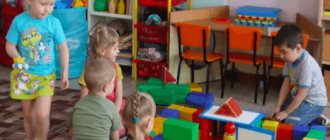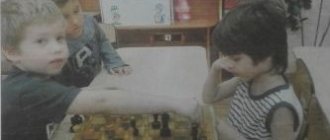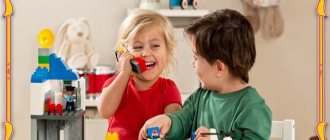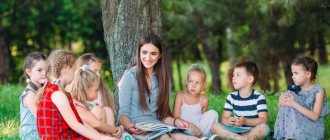What are the benefits of playing outside?
Playing in the fresh air promotes physical development, but not only that – it helps the child explore the world and allows him to feel more confident in it.
For young children, open space is essential: it gives them a sense of novelty, the anticipation of adventure and discovery, and allows them to explore the world around them at their own pace. During games and active activities, children test their strength, demonstrate their abilities and gain self-confidence. It is recommended to walk them several times a day.
On the street, children have enough space for running, jumping, football, fights, hide and seek, tag and other games that require space. Such loads are necessary for the health and full physical development of the child.
For children who spend a lot of time in front of screens, playing outside is especially important: it reduces the risk of developing myopia. And time spent in the sun is valuable because it stimulates the production of vitamin D in the body.
Young children require constant supervision and parental attention. The older they get, the more independence you can give them. Sometimes all you need to do is let them out of the house into a safe space and let them make up their own games.
Let's learn words and explore the world.
During a walk, you can significantly increase your child's vocabulary and expand his knowledge about the world around him.
To do this, every day, when going for a walk, explore with your child some separate object in the surrounding world.
Vocabulary topics that are suitable for this age:
1. Trees (we study the structure of a tree: trunk, leaves, roots, branches, “a tall tree” (we show with our hands how tall it is), and the blade of grass is low).
2. Cars (we study the structure of the car (wheels, mirror, window, driver’s seat, steering wheel, color of the car).
3. Children's playground (name of the main objects of the playground (slide, bench, their color).
4. Vegetation (flowers, grass, bushes - structure, properties).
5. Insects, birds, animals (dogs, cats, etc.) – names, onomatopoeia, observation of behavior.
6. Houses, entrance, staircase (structure (windows, steps, etc.), size).
7. Objects of nature (sun, moon, puddles, stones, twigs, etc.).
8. Understanding the world (discussing everything that comes along the way).
Let's save ourselves from routine!
When you have “clearly” worked through all the above lexical and cognitive topics with your child, you can move on to something more interesting - once or twice a week (as often as you feel most comfortable with), go with your baby to some new place ( a store, a park, or better yet, those places that you personally want to visit ). It doesn’t have to be a grandiose zoo on the other side of the city (let’s be honest, getting there with a baby can be a little difficult). This could be a neighboring area, a park that is a little further than you usually walk, a new street, or even a bank or hotel with a nice design that you are interested in gawking at.
Once in a new place, explore and “name” to your baby the new items and objects that you see there.
Such “outings” will not only develop your child, but will also help you deal with the problem of many mothers raising babies - routine.
How to study objects of the surrounding world with a baby from 1 to 1.5 years old:
1. Repeatedly tell the child the word that this object is called. (“Here’s a tree, let’s touch a tree? That’s a tree! A tree!”)
2. Let us touch the object with our hands - children love to explore the world in this way.
3. We talk, show and let you touch what the object is made of, talk about its characteristics (here is a car, look at its wheels, and here is the door, and here is the steering wheel - the driver turns it, etc.)
3. Adjectives and verbs.
In the development of speech in many children under 2 years of age, much attention is paid to the study of nouns (cat, mother, apple, turkey, etc.). And this is correct and fully corresponds to the developmental psychology of a child of this age.
But at the same time, it wouldn’t hurt to study many types of verbs and adjectives with your child.
Therefore, it is appropriate to use your walk to study these parts of speech, for example:
Adjectives : big, small, hard, soft, good, beautiful, long, short, etc.
For each walk, you can identify one or two adjectives that you would like to pay attention to, find objects for which this adjective can be applied (big stone, small stone, etc.) and pronounce them to the child.
Verbs : goes, stands, climbs, digs, rides, flies, grows, etc. Using the same scheme as with adjectives, you can study verbs with your child: having chosen one or two significant verbs, perform with the child the action that they mean and name these verbs.
Onomatopoeia.
The first words spoken by most children aged 1 to 2 years are onomatopoeic in nature. (A child may call a dog “ba” or “ava”, a ball “ik”, etc.).
This use of onomatopoeia in speech is quite natural - the baby first learns to pronounce the simplest speech structures, consisting of 1-2 sounds, and gradually, as speech develops, complicates them.
This is why it is so useful to teach your child various onomatopoeias. Since “aw-aw” is much easier to say than “dog,” children easily master onomatopoeia and, having trained their speech apparatus, gradually move on to more complex words. (Of course, you should not replace onomatopoeia with real words. Emphasize that this is a “dog”, but it says “av-av”, this is a “ball”, and it falls “boom”, etc.).
What onomatopoeias and simple words are “convenient” to develop while walking:
“Boom”, “bang”, “bang” - when objects fall. You can periodically play a fun game - throw various objects on the floor (sand molds, sticks, etc.) and together voice how they fall - “Bam.”
“Beep beep” - that’s how the car beeps.
“Knock-knock” - that’s how the stick knocks.
“U-oo-oo” - this is how the plane flies (when pronouncing this sound, draw the child’s attention (i.e. just point your finger and tell him about it) to the fact that your lips are folded into a tube - this will make it easier for him to repeat after you sound).
“Na”, “give” - when exchanging objects.
"Not really".
"Peek-a-boo" - in various games.
5. Soap bubbles.
It's more about fun than development, but playing with bubbles will bring great joy to your child.
Blow bubbles for your baby, and together with him try to “catch” them by clapping your hands.
We study geometry.
While walking, you can study geometric shapes. Take a stick and draw a circle, square, triangle on the ground.
Taking the child by the armpits, “jump” with him along the resulting figures, each time pronouncing the name of the figure “jump, this is a square!” “a jump is a circle”, etc.
What happens: of course, a child will not “learn” all the basic geometric shapes in one walk. But if you do this often (especially if it intersects with home exercises), after a few months your baby will be quite capable of distinguishing a square from a circle.
Music.
Yes Yes! You can have a real musical session while walking! Play little drummers!
Give the child a stick, take his hand with the stick in yours, start singing a simple children's song (“Antoshka”, “Two Cheerful Geese”) and, together with the child, “hand in hand” knock on the bench, beating out the rhythm to the beat of the song.
Some time after the start of the song, you can release the baby’s hand and give him the opportunity to accompany you on his own (children aged 1 to 1.5 years do many things with pleasure, simply imitating their mother; therefore, everything will work out much better if you, while next to you, you will also drum on the bench with a stick).
Is it possible to go out with the children for a walk?
It’s probably been a long time since parents spent as much time with their children as during self-isolation. They got to know each other better and played most of the games available within their four walls. Moreover, in many families, thanks to isolation, the range of home games has expanded significantly. Moreover, they have become a kind of way of communication between adults and children.
In many regions it is already possible to go on family walks, although with reservations. These restrictions mainly relate to the number of people (maximum two people, not including children) and social distance (1.5–3 meters - depending on the region). If your neighbors have families with young children who are also serious about limiting contact, you can team up and teach your children non-contact but fun games from our childhood, such as the old game of secrets.
During self-isolation, both adults and children became a little unaccustomed to street life. Therefore, when returning to fresh air, you need to be especially careful to avoid not only infection, but also injury.
On warm days, you especially want to go out and play with your children in the fresh air, even if there are not yet many places where this can be done safely. Suitable options include a forest near a city house, a house in a village or a summer cottage.
If parks in your city are already open, try to find time to walk there, especially if playgrounds are still prohibited. In the park, the child will have even more space for running, cycling, scootering and other active activities. And the road to the park and back is an opportunity to introduce your child to the rules of the road and show him an example of safe behavior on the street.
Educational games for a walk
If we look at any playground, we will see, as a rule, the same picture: children dig in the dirty sand, slide down a dilapidated slide or climb onto a rickety ladder, and mothers chat on a nearby bench, only occasionally glancing towards their children : whether they got into a fight, fell over, or ate too much sand. For some reason, parents are sure that a walk is their time of legitimate rest from their child, and their responsibilities boil down only to monitoring his safety. Of course, the baby needs time to independently explore the world, to play with other children, but it often happens that the children are clearly bored or, conversely, overexcited and unable to play on their own, and the mother only about At the same time, the same mothers constantly complain that they do not have enough time for anything in general, and in particular for activities with the child. But it is a walk that opens up unique opportunities for activities with children.
You are supporters of Glen Doman's ideas
and do you like to show your baby cards with signatures? Amazing! Go to the nearest forest park, to the river bank, to the boulevard, or just to a green corner of the yard. Write on the cards the words “earth”, “grass”, “tree”, “dandelion”, pine cone, “bark”, “shore”, etc. and place them directly on the ground, attach them to tree trunks, lean them against flowers. Now take your baby around this magical clearing, reading the cards to him. Even a ten- to eleven-month-old baby, not to mention older ones, will be delighted with such a game. An older child can be invited to play in the “museum of wildlife”, let him place the cards correctly in front of the “exhibits”. If your baby can’t read yet, help him: “Where is the dandelion? Take the signature to him!” “Here I write: “pine”, and for now you look for where to attach it.” A two or three year old will be happy to take part in collecting a herbarium in the summer or collecting seeds in the winter. You will then sort all the samples together, arrange them and sign them.
Well, where else if not to study the basics of geography and astronomy
? Take a compass with you and explain to your child how to determine the cardinal directions, and at the same time tell us how to navigate without a compass. Four or five year olds can already be told how to use a plan and a map of the area (this is written very well and in detail in the book “Educational Games” by B. Nikitin). You can even go on a real little hike by determining the route in advance using a map. On a clear winter evening, when it gets dark early, try to find the North Star, Ursa Major, and other constellations in the sky. Show your baby the Moon in different phases and tell them about their changes. Find an open area where you can easily see the sunset. This sight will shock even the tiniest kids.
Birds and insects
- the most accessible representatives of the fauna for city residents. Grab crumbs for ducks and pigeons, make a feeder for bullfinches and tits in the park. Teach your child to quietly watch birds. It's good to come regularly to the same place. For example, in early spring you can watch how drakes take care of ducks, in summer you can admire ducklings, and in autumn you can watch how ducks prepare to fly away. You can also remember the fairy tale about the Gray Neck.
Find an anthill and observe its inhabitants, tell your child how hardworking ants are, how they live as a big happy family. If you take a magnifying glass with you, you can carefully examine the ant or other insect. Just do not allow your child to torment insects and birds under any circumstances. But you can take the caterpillar home, put it in a jar and try to turn it into a butterfly. Be sure to pay attention to which leaves the caterpillar was sitting on: they should be fed to it.
you can do math while walking
. Well, where else if not in the forest to master the concept of ten? Collect, for example, several dozen cones or pebbles, arrange them in previously prepared boxes or simply on large leaves - here is a mathematical guide for you. Sandy and asphalt areas are suitable for geometry classes. You can draw with a stick or chalk, and if several children get together, invite them to turn into geometric shapes themselves: by extending strings to each other, the kids will be able to make a triangle, square, rhombus... If you grab a tape measure or folding meter from home, you can start measuring distances, calculation of perimeters and areas (for example, a site for the construction of a castle)
If you value Montessori ideas
, stock up on vessels of various sizes to pour and measure the amount of various liquids and bulk solids, you can also take a steelyard. A sandbox or the shore of a pond is an ideal place to study the concepts of many-little, heavy-light, liquid-solid. And fiddling with sand, water, small pebbles and cones will strengthen the baby’s fingers and develop fine motor skills.
You can try speaking as a child during a walk only in a foreign language.
(provided, of course, that you yourself speak it fluently enough or at least with correct pronunciation and without gross errors).
From time to time (but not very often, so as not to get tired) take paper and paints or pencils
and play “sketching artists.” Explain to your child how to sketch plants, animals, people, and draw landscapes. Just don’t demand similarities, let him draw as he wants. And if you also draw (not for the child, but next to him!), it will be absolutely wonderful. Then it will even be possible to arrange an exhibition.
Yard games
The children of our childhood are gradually passing away, and today’s children do not know how to organize group play at all. Therefore, on the playground it is worth trying to arrange general games for kids, from “loaf” and “stream” to lapta and “Cossack robbers”. Perhaps you know some rarer ancient games or you can come up with them yourself - so much the better. After all, in any group games, your child gains invaluable experience of communication and cooperation, which will be so useful to him in life.
And yet, the most important thing during a walk is the discoveries that your baby will make on his own, the communication experience that he will gain while playing with other children. Therefore, do not rush and do not impose your program on the child, but intervene tactfully and discreetly when you feel that the baby is already tired of having fun on his own.







